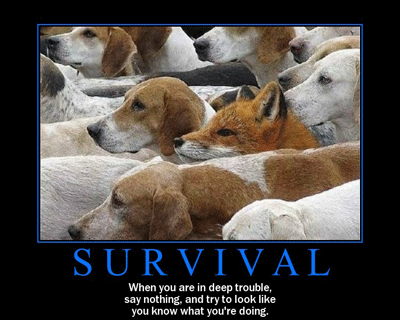I am discontinuing both blogs and moving everything over to the new website where it will be more organized.
http://consfearacynewz.weebly.com/#/
Sunday, December 2, 2012
Friday, November 30, 2012
Friday, November 2, 2012
Preppers are the new prophets:This is why you need to prepare
Preppers are the new prophets
In the wake of Sandy, preppers suddenly seem like geniuses. While being ridiculed by the rest of the population for as long as we can all remember, preppers are the ones still standing in the aftermath of the storm.
They’re the ones you don’t see on the news, begging for help and panicking over the situation, because the preppers are sitting in their homes, eating their stored food, drinking their filtered water, double-checking their shotgun loads and staying off the streets. Preppers are the ones NOT looting, NOT complaining about the Red Cross, and NOT diving in dumpsters to find food while waiting around for the government to show up and save them.
Preppers are the new prophets. And those who failed to prepare are the new homeless.
72 Hours After Grid-Down: Starvation, Supply Shortages, Food Lines, No Clean Water, No Gas, Transportation Standstill
Mac Slavo
SHTFPlan.com
Nov 2, 2012
SHTFPlan.com
Nov 2, 2012
A recent study noted that the majority of people have enough food in their pantries to feed their household for about three days and that seemingly stable societies are really just nine meals from anarchy. With most of us dependent on just-in-time transportation systems to always be available, few ever consider the worst case scenario.
For tens of thousands of east coast residents that worst case scenario is now playing out in real-time. No longer are images of starving people waiting for government handouts restricted to just the third-world.
In the midst of crisis, once civilized societies will very rapidly descend into chaos when essential infrastructure systems collapse.
Though the National Guard was deployed before the storm even hit, there is simply no way for the government to coordinate a response requiring millions of servings of food, water and medical supplies
Many east coast residents who failed to evacuate or prepare reserve supplies ahead of the storm are being forced to fend for themselves.
Frustration and anger have taken hold, as residents have no means of acquiring food or gas and thousands of trucks across the region remain stuck in limbo.
Limited electricity has made it possible for some to share their experiences:
Via Twitter:
- I was in chaos tonite tryin to get groceries…lines for shuttle buses, only to get to the no food left & closing early (link)
- I’m not sure what has shocked me more, all the communities around me destroyed, or the 5 hour lines for gas and food. (link)
- Haven’t slept or ate well in a few days. Hope things start getting better around here soon (link)
- These days a lot of people are impatient because they’re used to fast things. Fast food, fast internet, fast lines and fast shipping etc. (link)
- Glad Obama is off to Vegas after his 90 minute visit. Gas lines are miles long.. Running out of food and water. Great Job (link)
- Went to the Grocery store and lines were crazy but nail salon was empty so I’ve got a new gel manicure and some Korean junk food (link)
- So f*cking devastated right now. Smell burning houses. People fighting for food. Pitch darkness. I may spend the night in rockaway to help (link)
Things are starting to become horrific for the unprepared, as food lines stretch for miles and Meals-Ready-To-Eat are in short supply:
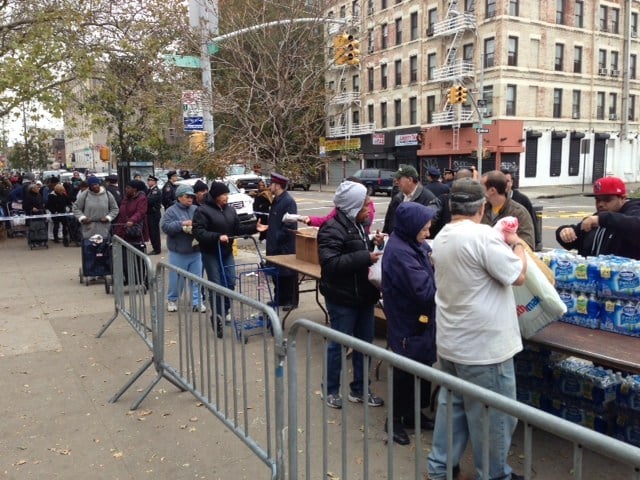
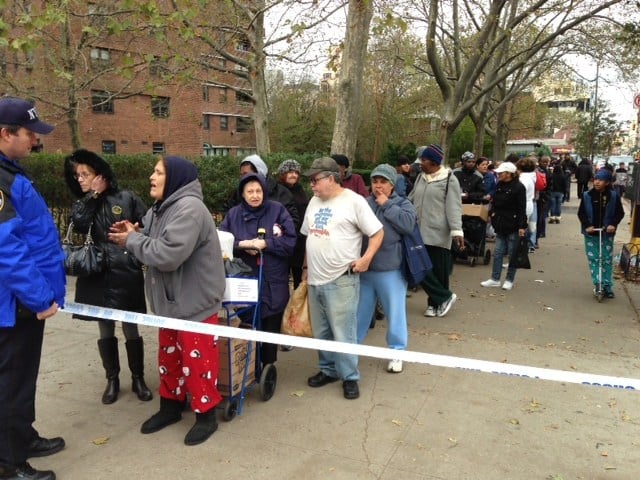
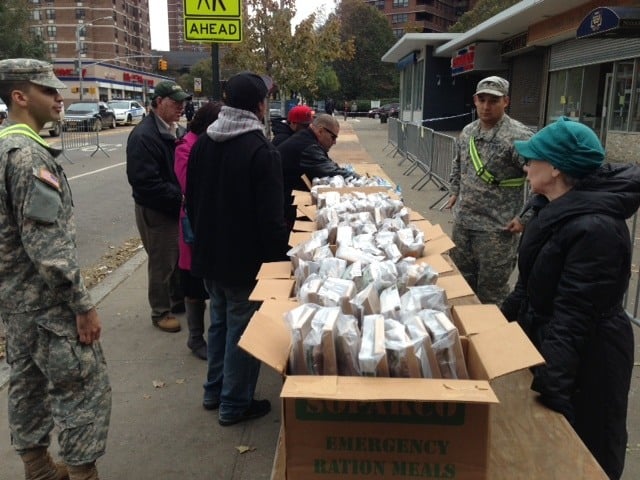
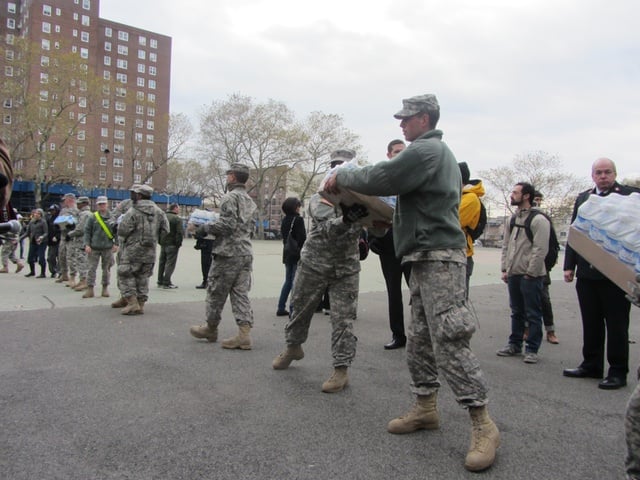
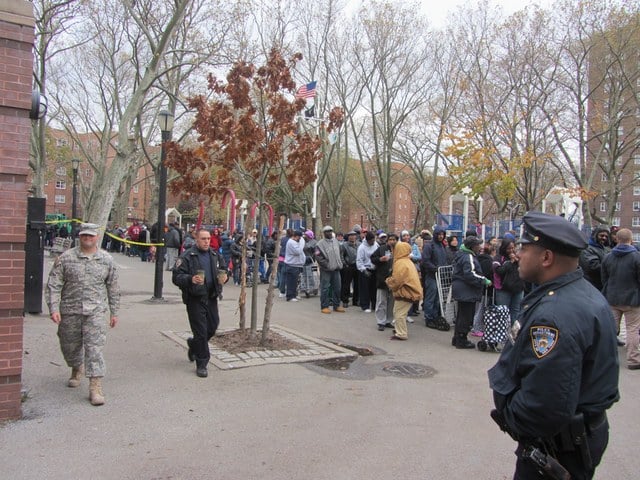
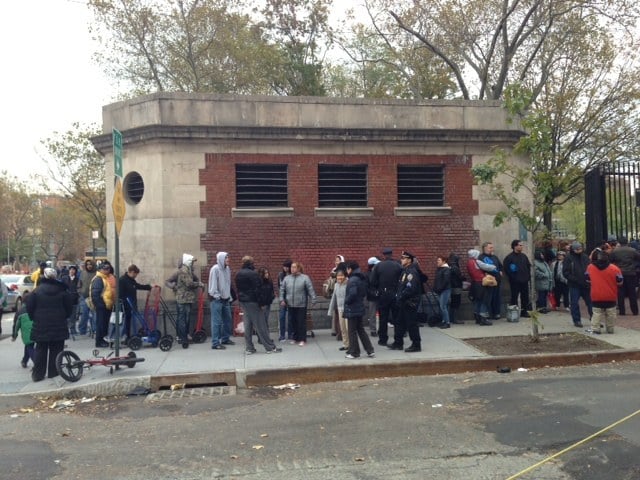
(above images via Gothamist)
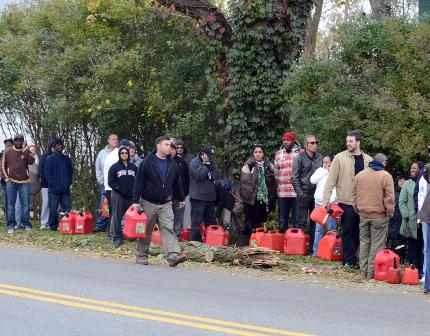
With mass transit out of service and no gas, residents have no choice but to commute by foot. Survival Blog founder James Rawles has referred to the masses of starving people who will roam the streets in a post-collapse world as the Golden Horde – here’s a small taste of what that will look like:
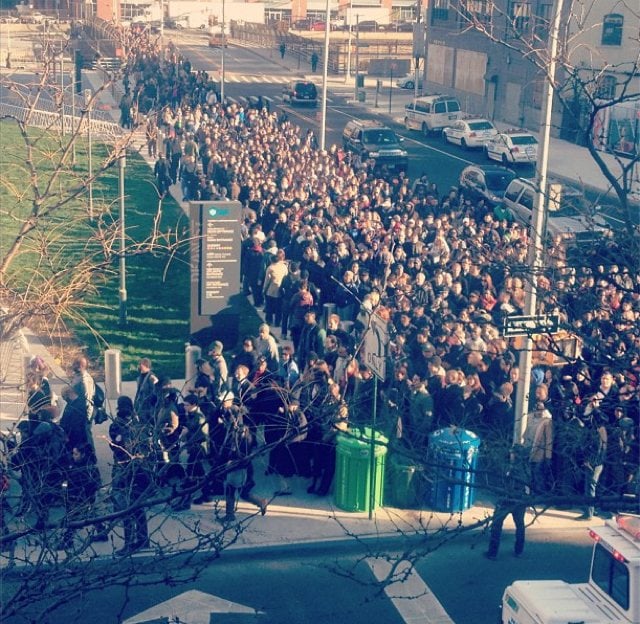
The situation has become so desperate that some have been forced to resort to rummaging through the garbage for food:
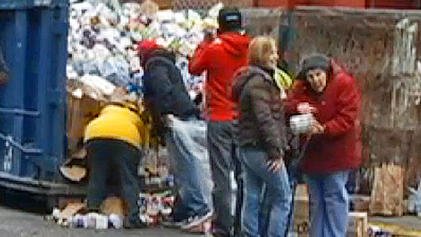
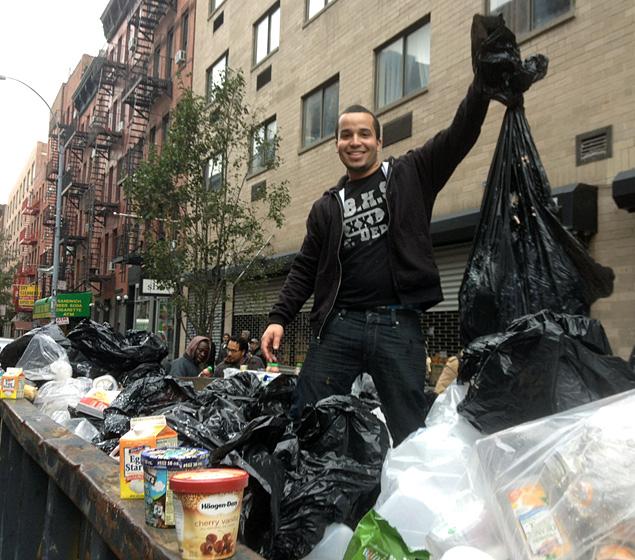
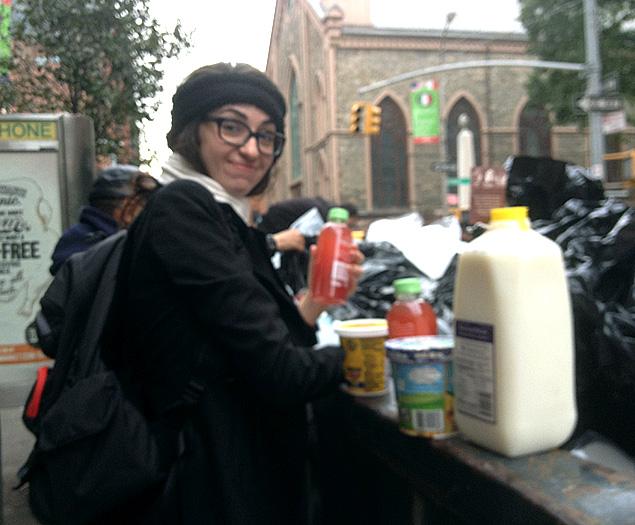
Video:
“We’ve seen everyone here from the elderly, to families with children…”
A simple 72 hour survival kit and some basic hurricane preparedness would have prevented days of heartache for residents of stricken areas.
The vast majority of those waiting in mile-long long food lines, rummaging through the trash, and criticizing their government officials for a slow and insufficient response have no one to blame but themselves.
This may be harsh – but it’s true.
We wish all those having a difficult time dealing with the aftermath of Hurricane Sandy the best going forward. Perhaps it will be a wake-up call for the rest of the nation.
Hurricane Sandy, while disastrous, is not nearly as bad as it could have been.
It has happened before. It will happen again. Prepare or suffer the consequences.
Mike Adams
Natural News
Nov 2, 2012
Natural News
Nov 2, 2012
The first 72 hours after a natural disaster are the “polite” hours. Residents operate under the illusion that Big Government will soon save them with emergency supplies: food, water, fuel, clothing and more. So they follow the rules and “play nice.”
After about the third day, all those social niceties start to erode. People are hungry and angry. There’s a feeling of desperation and even abandonment. What seemed to be a polite society two days earlier suddenly becomes more sinister. The survival needs of individuals begin to outweigh social boundaries, and what emerges is desperation… even panic.
“Dwindling gasoline supplies are causing frayed nerves as the region endures its third full day with massive power outages.” reports Fox News. “Frustration with gas supplies topped the list of issues causing tensions to boil over in New Jersey, New York and Connecticut, the states hardest hit by power outages in the wake of superstorm Sandy. Residents jockeyed for fuel at the few stations still pumping, searched store shelves in vain for batteries, struggled with sporadic cell phone service and found themselves unable to buy necessities at supermarkets.”
State troopers have now been deployed to gas stations in an effort to head off near-riots as citizens lose patience and tempers flare.
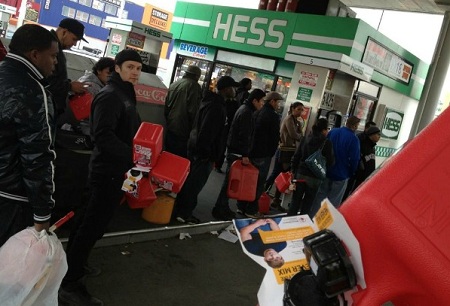
On Twitter, fist fights are being reported over fuel shortages. Police have had to draw guns on some people, reports Brietbart.com.
That article includes posts from Twitter users:
You know things are bad when you ask the gas station attendent “when do you think you’re going to get more gas?” and he just laughs at you. – Prede (@predederva) November 1, 2012
Just awful! RT @metrogypsy: Someone just pulled a knife at Greenpoint #gas station as line stretches with hours long wait #gettingrealFAST – Camila Xavier (@camilaxavier) November 1, 2012
Watching the breakdown of society at a gas station on Long Island. #sandysucks – Christina (@wooly_says) November 1, 2012
There are also tweets from some users who are intelligent preppers… like this one from JohnnyRH:
I live in Utah and the people here are big into “prepping”… I have relatives in NJ and just last week we were talking and they thought I was nuts to own guns, store fuel and water and have a generator. Most people are totally blind to what chaos will come with a really large power grid failure over half or all of the country. It will take little more than a week for all hell to break loose and riots will be the norm.
“We’re going to DIE!”
Another report from ABC News reveals the desperation and panic now forming among residents in Staten Island.
“We’re going to die! We’re going to freeze! We got 90-year-old people!” Donna Solli told visiting officials. “You don’t understand. You gotta get your trucks down here on the corner now. It’s been three days!”
The situation is so bad that even the Red Cross is being blamed for not showing up with supplies:
“This is America, not a third world nation. We need food, we need clothing,” Staten Island Borough President Jim Molinaro said today. “My advice to the people of Staten Island is: Don’t donate to the American Red Cross. Put their money elsewhere.” (ABC News)
NBC News reports:
Staten Island officials had some choice words Thursday to describe what they said was a feeble disaster-relief response to people left dying, homeless and hungry in the New York City borough hit particularly hard by Sandy. Staten Island’s top elected official blasted the American Red Cross response as “an absolute disgrace” and went so far as to urge its residents not to donate to the largely volunteer agency.
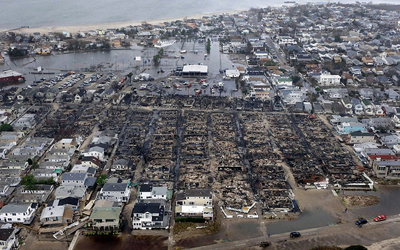
No gas for a week, no power for two
This situation, by the way, is only going to get FAR WORSE before it gets better. CNBC reports gas shortages will continue for at least a week, possibly longer. That’s seven more days even while desperation has already taken hold on day three!
And power? Con Edison says it will be another 10 days before power is restored to the majority of customers currently in the dark.
As long as the power is out, gas stations can’t pump gas, and that means continued gas shortages. That, in turn, means more desperation, starvation and even panic as residents can’t use vehicles to acquire food and supplies. The American way of life, remember, is almost unimaginable without gasoline. Half the population seems physically incapable of walking anywhere these days, and almost nobody own bicycles anymore.
Things are going to get a lot worse over the next few days
What happens when millions of people packed into high-density cities can’t get food, fuel or electricity?
People get desperate, of course. Desperation is about to set in. In the days ahead, you’re going to see more fights and even weapons brought to bear in real-life survival scenarios. The federal government will predictably fail to reach people with the help they need, and people who neglected to prepare will find themselves in ever-more-desperate circumstances.
This is a time when nearly everybody suddenly realizes gee, it sure would have been smart to have been a prepper.
What’s the value of having emergency food, fuel, a water filter, batteries and a fully loaded Remington shotgun in the hours after a superstorm? Priceless.
Preparedness is the solution
What’s the solution to all this frustration and panic? Preparedness.
If the people of Staten Island or NYC had been prepared for the storm that they knew was approaching, they wouldn’t be in a state of desperation right now!
If they had stored some of their own food, fuel, water and emergency supplies, they wouldn’t be panicked for the Red Cross to show up and save them.
If they had intelligently planned ahead and taken action based on the seven days of dire weather predictions that preceded the storm, they wouldn’t need to beg for big government to bail them out!
The answer to disasters like Sandy is to be a prepper.
Preppers are the new prophets
In the wake of Sandy, preppers suddenly seem like geniuses. While being ridiculed by the rest of the population for as long as we can all remember, preppers are the ones still standing in the aftermath of the storm.
They’re the ones you don’t see on the news, begging for help and panicking over the situation, because the preppers are sitting in their homes, eating their stored food, drinking their filtered water, double-checking their shotgun loads and staying off the streets. Preppers are the ones NOT looting, NOT complaining about the Red Cross, and NOT diving in dumpsters to find food while waiting around for the government to show up and save them.
Preppers are the new prophets. And those who failed to prepare are the new homeless.
Friday, October 26, 2012
Evacuation plan – Planning to bug out during an emergency
Having an emergency evacuation plan is critical in any survival situation. If the SHTF, having a plan of action will put you about 20 steps ahead of the mindless morons who spent their time watching T.V.
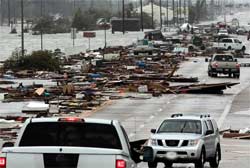 Your Evacuation plan should take into account the following things:
Your Evacuation plan should take into account the following things:
Most likely emergency scenarios
Put on your thinking cap! Start to list the most likely emergency situations that can take place. Hurricanes, Earthquakes, Civil Unrest, War, Riots, Nuclear or Terror Attacks, Etc…
Sketch out some ideas of what you would do when the SHTF and put together a custom survival plan for each scenerio.
Stay or Go?
This decision can be huge; each choice has benefits and risks associated with it. Think about what things would have to happen to make you leave your home. Hint: if you waited for the government to issue mandatory evacuation orders, you waited to long.
Meet up place
When disaster hits there is a good chance that your family may not be together. Now is the time to decide on a family meeting place. Pick a place that is easy to find and make sure each member of your family can find it during an emergency.
Have multiple routes out.
Keep in mind that during a disaster most of the major highways are going to be completely clogged with people trying to get out. Plan now, and map out as many routes as possible. Use Google Maps to print out possible evacuation routes and then laminate the paper so it hold up when you need it.
Don’t forget to print out vehicle and walking routes (hiking trails, railroad tracks, side roads etc… should all be considered.)
Survival Supplies:
What items do you need to survive for 72 hours, a week, a month or even indefinitely? Put together a survival / Bug Out Bag of essential items that you will need to survive each situation.
Your bag should be designed around your family, climate and health. There is no one size fits all bag, so make sure you pack the items that you need to survive.
Where will you go?
Bugging out without a place to go isn’t a plan. Make sure you know where you are going before disaster strikes. If you don’t own land or a second house, then look for areas to camp that can sustain you and your family.
You may also want to look into investing in a bug out vehicle, a 4 season tent or a small travel trailer.
Bug Out Bags for Kids
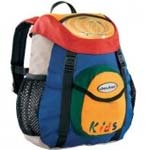 Do you have a BOB for your kids?
Do you have a BOB for your kids?
During a SHTF situation it will be important for your kids to feel as safe and secure as possible. Having their own child sized Bug Out Bag filled with familiar items and comfort foods can be a real life saver during an emergency.
With children comfort items often become a top priority to ensure their overall mental health during a SHTF scenario.
What Items should go into a kids bug out bag:
Basic Survival Items: Make sure they are light weight and age appropriate, heavier items and gear should be in the adults bags.
- Flash light
- Emergency whistle (clipped to the outside of pack so they can easily find it if they become separated from you)
- Laminated emergency contact list with name, home address, and telephone numbers.
- Pre paid cell phone
- Poncho
- Extra socks, pair of gloves and knit hat or bandana (depending on your climate)
- Dust mask
- Goggles
- Small pocket knife for the older kids
- Band aids & wipes
- Small bottle of hand sanitizer
Comfort Items
- Stuffed animals
- A couple small light weight toys
- Pack of playing cards or travel size games
- Baseball or small Nerf football
- Harmonica
- An Ipod or small device to play games and listen to music
- Hard candy
- Bubble gum
- Sugar packets
- Trail mix
- Drink mix packets
Remember a kids bug out bag is not meant to be an adult BOB. It’s main purpose is to comfort your child during a stressful situation and give them a feeling of control. With younger children comfort items are a top priority and will help to ensure their overall mental health.
Make sure you customize the bag for your child’s age, personality and overall fitness level.
Ultralight Bug Out Bags – Lighten your load
Carrying a heavy backpack can be a real pain in the BACK!
The last thing you need in a bug out situation is to be carrying any unnecessary weight. When it comes to Bug Out Bags I take a minimalist approach to what I carry and tend to use a lot of lightweight hiking gear.
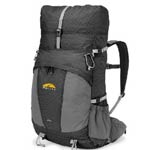 Here are Six ideas that you can use to cut down the weight in your Bug Out Backpack
Here are Six ideas that you can use to cut down the weight in your Bug Out Backpack
Break out the scale
When I’m light hiking I rarely carry over 15 pounds of gear including food and water. It may sound a little crazy but I actually calculate how much each piece of gear weighs on paper before I ever add it to my pack. Trust me when your a couple days into a long distance thru-hike you will be wishing you would have put a little bit more thought into your packs weight.
Pick backpacking gear that is multipurpose
To cut your packs weight try to select gear that can be used in a number of situations. Items like Bandanas and tarps are great multipurpose pieces of gear that are not only lightweight but can be used in a variety of survival scenarios.
Shed those ounces….
Ultralight hikers are notorious for going to extremes to shave off even a few ounces from their packs weight. From drilling holes in equipment to removing tags, patches and other emblems from their gear light hikers will do just about anything to shed those extra ounces!
While some of the things they do may seem extreme, every little ounce eventually adds up.
Don’t forget the actual Pack!
One thing that’s often overlooked when trying to cut pack weight is the actual weight of the backpack. Ultralight backpacks have gotten so light that you can often shave over 5 pounds from your total weight just by switching to an ultralight pack.
Ditch the tent
If your carrying a tent you can cut your weight in half or more by switching to a tarp and hammock setup. While you can save even more weight by ditching the hammock, I like to carry one in certain areas of the country. They are a great for keeping you off the ground and away from dangerous little critters.
Carry Less Water
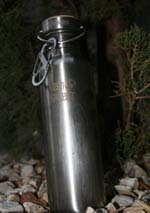 A gallon of water weighs over 8 pounds. When hiking I try to carry the least amount possible without running the risk of dehydration. When planning yourbug out or evacuation routes make sure you map out as many watering holes as possible. Knowing where you can find water can help you cut down on a significant amount of water weight.
A gallon of water weighs over 8 pounds. When hiking I try to carry the least amount possible without running the risk of dehydration. When planning yourbug out or evacuation routes make sure you map out as many watering holes as possible. Knowing where you can find water can help you cut down on a significant amount of water weight.
I usually carry a hiking water filter, one full canteen and one empty one. The empty one allows me the option of carrying extra water if I’m in an area where water is scarce. It also serves the dual purpose of being able to cook food our boil water over a campfire.
The canteen that I use is made by Klean Kanteen and is pictured on the right. They are one of the most well made canteens that I’ve found and are a great multipurpose survival item to carry. Click here to check them out on Amazon.
Survival Training

You’ve got your guns.
Your pantry is stocked full of food.
You’ve got so much gear, your bags are ready to explode.
Your pantry is stocked full of food.
You’ve got so much gear, your bags are ready to explode.
But are you really prepared to survive?
- Have you run through simulated scenarios?
- Have you tested your plans and looked for weak points?
- Do you know how to use every piece of gear in your bag and have you actually tested it?
Gear is great, but when it comes to survival nothing can replace knowledge, and good old fashion practice. To be truly be prepared, you need to start practicing your skills in a real world setting.
Here are a couple ideas to get you started:
Start hiking and backpacking
This will not only help you stay fit, which is an extremely important aspect of survival, but it will also prepare you both mentally and physically in case you have to bug out.
Build a fire pit in your backyard
Building a fire pit in your backyard can help you in a number of ways.
- It’s a great spot to practice fire starting techniques.
- It’s a great place to practice primitive cooking techniques.
- They’re good to have in case you’re ever without power.
Shoot, Shoot & then shoot some more
 Whether it’s for hunting or self defense, if you own a firearm it’s your responsibility to train and practice with that weapon.
Whether it’s for hunting or self defense, if you own a firearm it’s your responsibility to train and practice with that weapon.
How tragic would it be if after all of your preparation you found out the hard way that you don’t know how to use your gun? Think I’m being a little over dramatic? Think again!
Every year thousands of gun owners are killed by a criminal because they never learned how to properly use their gun. From forgetting to take the safety off to not knowing how to shoot, there isn’t a day that goes by where you don’t hear about a tragedy that could have been prevented through training.
Go hunting and fishing
Being able to provide for your family is not something that should be taken lightly. Even during the best of conditions there’s going to be times that you come up empty handed while hunting or fishing.
To give yourself the best chance of survival, you need to learn how to hunt and fish. The more you practice these skills the easier it will be to find food during a survival situation.
Finding the Ultimate Bug Out Property or Survival Retreat
When it comes to buying a survival retreat or bug out location, location really is the key. Here are some of the top considerations that you need to keep in mind when looking for the ultimate bug out location.
Bug Out Location Checklist
Distance – If you’re purchasing a piece of property to serve as a bug out location, then you really need to consider how far that property is from your current home. Any property that you can’t make it to on a single tank of gas should really be reconsidered.
If you’re looking for a fulltime survival retreat, distance isn’t really a problem. In fact, I would think the farther you can get away from the major cities, the better off you will be during a major collapse or SHTF situation.
- How far is the land from your current location, and would you be able to safely make it there during a crisis situation?
- How far is the land from high density population areas?
Water Sources – A good reliable water source is one of the most important considerations when choosing a bug out retreat. From fresh water springs and rivers to underground well water, the need for a clean and renewable water source is the number one factor to consider when looking for survival properties.
- What water sources does the land have?
- Are they renewable and will they be there year round?
- Is the property graded in a way that allows for a pond or cistern to catch rain water?
Concealment – The ability to hide or conceal your location may become necessary during a SHTF Bug Out situation. Having a location that provides adequate resources to conceal your living quarters might be another factor in choosing your location.
- How easy would it be for someone to wander on to your land during a bug out situation?
- Do the natural features of the land help conceal and shelter you, or are they an obstacle to using the land? This will be a difficult balancing act!
- Can you easily secure and defend the land?
Self-sufficiency – Picking a location where you can sustain your lifestyle is another important consideration. From having enough sunlight to maintain a solar system, to picking a location that provides a good amount of firewood to heat your home, the ability to sustain your lifestyle needs to be one of the top concerns on your BOL checklist.
Natural Resource – Another important factor in choosing your property is the area’s natural resources.
- How easy is it to grow food on your land?
- Does the area support a decent size population of wild animals for hunting?
- Can you easily raise livestock on the land?
Cost of Living – Unfortunately, the country is set up in a way that guarantees you never really own your property. From the government seizing homes over zoning issues, to having to pay taxes on a property that you already own free and clear, it seem our government always has its hands in our business. When considering your location, the cost of living needs to be factored into your plan. Property taxes, cost of local goods and your ability to keep up with your payments are all things that must be considered.
Zoning Issues – As we mentioned above, the government at every level has a way of really screwing with your plans. Make sure you thoroughly investigate local zoning ordinances and find out exactly what you can and can’t build, what permits are needed and how much trouble local zoning officials have been to local residents.
Population Density – During a crisis situation, areas with the highest population densities will experience the most crime, the most social unrest, the highest likelihood for epidemics, and the highest death tolls due to lack of resources and sanitation. When choosing a bug out location or survival retreat we suggest staying as far away from high density population areas as possible.
Natural Threats – From tornadoes and hurricanes to earthquakes and droughts, natural weather patterns and environmental threats need to thoroughly researched before deciding on a property. Make sure you know exactly what threats you will be facing and how the local climate will effect your ability to grow food, hunt and obtain resources throughout the year.
- Look at the areas historical data to better get an idea what the location might look like in the future. Take into account things like droughts, flash floods, tornadoes and earthquakes.
What’s a Bug Out Bag?
Most people who have a basic understanding of survival and preparedness understand the need for a good Bug Out Bag. It’s probably one of the most talked about items on survival websites and is something that has become a bit of an iconic symbol for preppers and survivalists. If you haven’t heard of the term Bug Out Bag you may have heard someone refer to it as a; Go Bag, 72 Hour Bag, Get Home Bag, Get out of Dodge bag or some other variation.
The basic idea behind a Bug Out Bag (BOB) is pretty simple. At its most basic, a BOB is a pre-packed bag filled with the gear and supplies you need to survive an emergency situation. It’s something that you can grab quickly, should a disaster or emergency situation occur that would require you to leave your location.
What items do you really need in your Bug Out Bag?
There really is no One Size Fits All Bug Out Bag solution. When it comes to filling your bag, a number of things need to be thought of; first and foremost should be planning.
Starting with a good plan is really the only way to get started. In order to know what items should go into your bag, you need to consider the following couple of things:
- What are the most likely disaster situations you will face? Part of truly being prepared for anything, means knowing exactly what situations you’re preparing for. Before buying gear for your bag, It’s a good idea to first figure out what situations you are actually preparing for. This will give you a good idea of what you need to pack, how long you need to pack for, and how much gear you will likely need.
- What Threats might you face? Understanding what threats you will face in an emergency situation is a crucial part of the Bug Out Planning Phase. Performing a threat assessment will help you figure out which items you need to pack and which items you can do without. I highly advise reading our article on Pre-Trip Planning for Backpackers it’s filled with information that directly relates to planning for a Bug Out Situation.
- What are your Strengths & Weaknesses? One of the things I often recommend for anyone serious about preparedness is to perform a SWOT Analysis. A SWOT Analysis is a simple but effective method of really understanding your Strengths and Weaknesses. By honestly assessing your situation, you will not only get a good idea of what areas you need to train in, but you will also get a good idea of what gear will compliment your strengths.
Once you’ve thought about the above considerations, you can then start to pack your bag. While there is no one size fits all solution, we do have a list of some gear that you may want to consider along with a list of some common Bug Out Bag Gear.
Considerations to think about before packing your BOB:
- Who will be traveling with you? Do they have any special needs or medical conditions that need to be addressed? Do they have their own bag filled with gear and will their gear compliment your own gear?
- Do you have a BOB for your kids? During a SHTF situation it will be important for your kids to feel as safe and secure as possible. Having a custom Bug Out Bag filled with familiar items and comfort foods can help defuse a stressful situation and give your child a sense of control. With younger children comfort items are a major priority that will help ensure their mental health during a stressful emergency situation.
- Are you actually prepared to Bug Out? It may sound like a silly question, but I don’t think most people realize what it’s really going to take to survive in a real-life bug out situation. It’s one thing to talk about bugging out, it’s another thing to carry your gear 10-15 miles a day in dangerous and unforgiving conditions.
- Do you need more than one bag? Since we have no way to know exactly when and where a disaster will happen, you might want to consider having a bag at home, at your office and in your vehicle.
- Don’t forget your EDC. Let’s face it, carrying 30 pounds of gear at all time is pretty impractical. Yes, you can have multiple bags stashed at your home, office and even in your vehicle, but no matter how much you prepare there are going to be times when you may not have access to your BOB. That’s why I suggest always having and carrying an EDC Kit.
- Do you have an evacuation plan? Having an emergency evacuation plan is one of the most important steps in preparing a Bug Out Bag. Having a BOB is great, but if you don’t have an evacuation plan and a place to go, what’s the point of having a bag?
THE BIG 4 – Water, Shelter, Food, Protection
In my opinion water, food, shelter and protection are the most important things that you can focus on. They are the fundamental building blocks to any good survival bag and should be the foundation that the rest of your gear is built off of.

While some of the items on this list may be considered optional, this is one survival category that’s definitely a necessity. Simply put, without it you’re dead!
Hydration Considerations:
- Gallon of Water per Day: While your exact needs will depend on a number of factors, including your environment, activity level, and overall health, a good rule of thumb is to carry a gallon of water per day per person.
- Water Bottles: Having a way to carry and store water is essential to your survival. I recommend the Klean Kanteen for its ability to carry and boil water right in the bottle.
- Water Filter: In my opinion a water filter is another important piece of gear. It helps you cut down on your overall water weight and gives you the ability to purify even the most disgusting sources of water. There are a number of quality water filters on the market, but so far there’s only one that I trust enough to carry in my bags. I recommend checking out our Katadyn Pocket Water Microfilter Review.

Your ability to regulate your internal body temperature, and protect yourself from the elements, is going to be extremely important during any type of survival situation. Shelter is one of those survival necessities that can literally mean the difference between life and death.
The type of shelter you choose will depend on your situation, your environment and your overall ability to improvise shelter from local materials.
Shelter Considerations:
- Clothing: Although some people might not consider clothing to be shelter, I believe it’s one of the most important items in this category. In a survival situation the clothes on your back, combined with what’s in your bag, will be your primary source of shelter and protection. Clothing is your first line of defense against the elements and is something that should never be overlooked.
- Portable Shelters: Some of the most common items include, a small tent, a lightweight tarp, sleeping bags, a Bivy Bag and even plastic sheeting.
- Insulation: In a survival situation knowing how to properly insulate yourself and your shelter can mean the difference between life and death.

While food probably won’t become a top priority in a short term emergency situation, it is something that needs to be considered.
When it comes to choosing the right type of survival foods, keep in mind that your caloric needs are going to be much higher than they are today. Energy bars, trail mix, nuts and seeds are all things that take up little room in your pack, but deliver an enormous amount of calories, protein, essential fats and energy producing nutrients.

One important, but often overlooked category is protection. No not that kind of protection, get your mind out of the gutter. The kind of protection I’m talking about is firearms and knives.
The great thing about this category is the items really serve dual purposes. From hunting to protecting yourself from wild animals, criminals and anything that wants to do you harm, protection is one of the top 4 things you need to consider carrying.
The Key to Building the Perfect Bug Out Bag is Testing
You can have the best gear that money can buy, but if you fail to train yourself with that gear, you might as well fill your bag full of candy because it’s not going to do jack shit for you in an emergency situation.
I don’t mean to be harsh, actually yes I do. Your Life Depends on it!
The key to survival is knowledge, testing and training. Please take the time and learn how to use your equipment in a real world setting. Reading about it is one thing, really knowing how to use it in a crisis situation can only be achieved through experience and rigorous training.
EDC Bug Out Kit – Your Every Day Carry Solution
While most Bug Out Bags, Get Home Bags, and 72 hour kits that you read about focus on long term survival, there’s one area that’s often overlooked.
What happens during those times when you can’t carry a bug out bag?
Let’s face it, having a 30 pound bag of gear at your side at all time is pretty impractical. Yes, you can have multiple bags stashed at your home, office and even in your vehicle, but no matter how much you prepare there will be times when you become separated from your gear. That’s why I suggest always having an EDC Kit.
What is an EDC Kit?
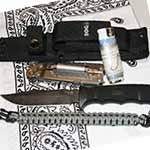 EDC stands for Every Day Carry, and is made up of items that you should have on your person at all times. They are usually relatively small, but contain everything you need to survive in an emergency situation.
EDC stands for Every Day Carry, and is made up of items that you should have on your person at all times. They are usually relatively small, but contain everything you need to survive in an emergency situation.
While most of us who are prepared will always have our important gear close at hand, there will be times when we may become separated from our main supply source. In this case having an EDC will help us either get to our main source of gear, or provide us with enough supplies to make it through the emergency at hand.
Examples of Every Day Carry Kits (EDC)
In most cases, your EDC should be small enough to fit in a pocket. It should only include gear and supplies that you feel are absolutely necessary to help you survive.
The Infamous Altoids Survival Kit:
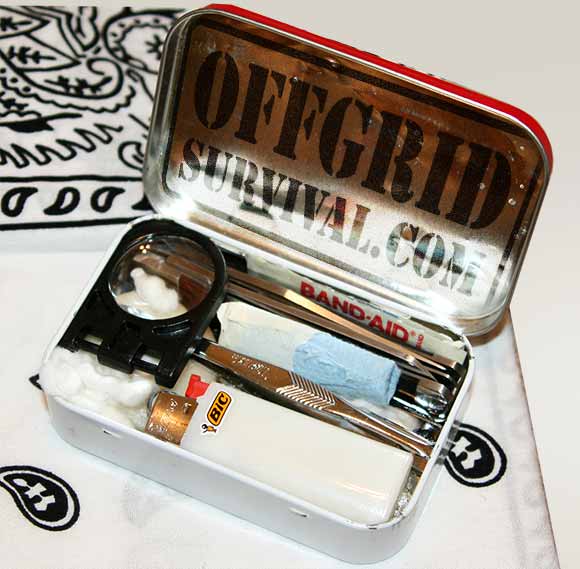
The Tin Kits are a great way to pack a bunch of survival supplies into one little easy to carry kit. This specific kit has:
- Pocket Knife (Swiss Army Style)
- Basic Medical Supplies (Butterfly bandages, tweezers, scalpel blades, & small magnifying glass which can also be used for starting fires)
- Spool of Dental Floss (Dual Purpose uses; cordage, fishing line, medical uses such as suturing wounds)
- Tinder (Cotton shoved into all the little crevices)
- A couple needles, fishing hooks & weights, zip ties)
- Bic lighter & a couple half match sticks with striker in plastic wrap.
- Small LED flash light
- Bandana wrapped around the case.
Compact Knife Sheath Kit:
Personally I like to carry a knife that packs a little bit more of a punch. This kit allows me to carry a decent size knife while being able to add a number of items right to the front pocket of the Sheath. In this case I am showing the SOG Seal PUP Elite with Nylon Sheath.
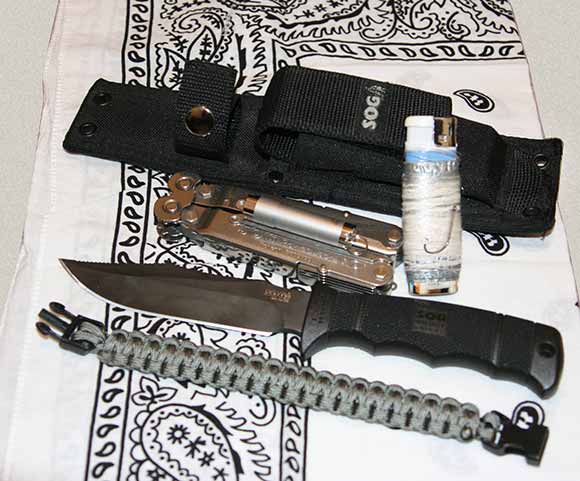

The Knife Sheath kit fits:
- The SOG Seal Pup Knife
- A Lighter Wrapped with Duct Tape & then fishing line (in between the line and the tape there are a couple needles and fishing hooks.)
- SOG Mulitool
- Mini LED Flashlight
- 550 Paracord Wrapper
Other items that you should always carry as part of your EDC:
- Cell Phone
- Handgun
- Cash (During an emergency situation, where the power lines go down, you are going to need some cash in your pocket.)
Subscribe to:
Posts (Atom)
